JEE Advanced (Subjective Type Questions): Straight Lines & Pair of Straight Lines - 2 | Chapter-wise Tests for JEE Main & Advanced PDF Download
Q.15. A line cuts the x-axis at A (7, 0) and the y-axis at B(0, – 5). A variable line PQ is drawn perpendicular to AB cutting the xaxis in P and the y-axis in Q. If AQ and BP intersect at R, find the locus of R. (1990 - 4 Marks)
Ans. x2 + y2 - 7x + 5y = 0
Sol. Eq. of the line AB is
 [A (7, 0), B(0, – 5)]
[A (7, 0), B(0, – 5)]
⇒ 5x – 7y – 35 = 0 Eq. of line PQ ⊥ AB is 7x + 5y + l = 0 which meets axes of x and y at pts P(– l/7, 0) and Q (0, – l/5) resp.
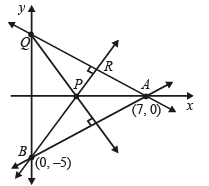
Eq. of AQ is,
 ........ (2)
........ (2)
Eq. of BP is,
 ......... (3)
......... (3)
Locus of R the pt. of intersection of (2) and (3) can be obtained by eliminating l from these eq. ' s, as follows

⇒ 35x (x – 7) + 35y (5 + y) = 0 ⇒ x2 + y2 – 7x + 5y = 0
Q.16. Find the equation of the line passing through the point (2, 3) and making intercept of length 2 units between the lines y + 2x = 3 and y + 2x = 5. (1991 - 4 Marks)
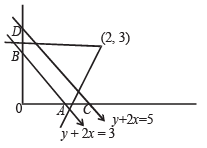
Ans. 3x + 4y -18 = 0 or x - 2 = 0
Sol. Let the equation of line through A which makes an intercept of 2 units between.
2x + y = 3 .......... (1)
and 2x + y = 5 .......... (2)
be
Let AP = r then AQ = r + 2

Then for pt P (x1, y1),





[Using 2x1 + y1 = 5 as P (x1, y1) lies on 2x + y = 5]
 … (i)
… (i)
For pt Q (x2, y2),



(ii) – (i)

⇒ 2 cosθ + sinθ= – 1 … (3)
⇒ 2 cosθ = – (1 + sinθ)
Squaring on both sides, we get
⇒ 4 cos2θ = 1 + 2 sinθ + sin2θ
⇒ (5 sinθ – 3) (sinθ + 1) = 0
⇒ sinθ = 3/5, – 1
⇒ cosθ = – 4/5, 0 [Using eq. (3)]
∴ The required equation is either

⇒ either 3x – 6 = – 4y + 12 or x – 2 = 0
⇒ either 3x + 4y – 18 = 0 or x – 2 = 0
Q.17. Show that all chords of the curve 3 x2 -y2 – 2x + 4y = 0, which subtend a right angle at the origin, pass through a fixed point. Find the coordinates of the point. (1991 - 4 Marks)
Ans. (1, –2)
Sol. The given curve is 3x2 – y2 – 2x + 4y = 0 … (1)
Let y = mx + c be the chord of curve (1) which subtends an ∠ of 90° at origin.
Then the combined eq. of lines joining points of intersection of curve (1) and chord y = mx + c to the origin, can be obtained by making the eq. of curve homogeneous with the help of eq. of chord, as follows.
⇒ (3c + 2m) x2 – 2 (1+ 2m) xy + (4 – c) y2 = 0
As the lines represented by this pair are perpendicular to each other, therefore we must have coeff. of x2 + coeff. of y2 = 0
⇒ 3c + 2m + 4 – c = 0 ⇒ – 2 = m . 1 + c
Which on comparision with eq. of chord, implies that y = mx + c passes though (1, – 2).
Hence the family of chords must pass through (1, – 2).
Q.18. Determine all values of a for which the point (α, α2) lies inside the triangle formed by the lines 2x + 3y – 1 = 0 (1992 - 6 Marks)
x + 2y – 3 = 0
5x – 6y – 1 = 0
Ans.
Sol. The points of intersection of given lines are

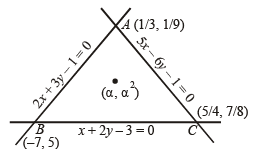
If (α, α2) lies inside the Δ formed by the given lines, then
 and (α, α2) lie on the same side of the line x + 2y – 3
and (α, α2) lie on the same side of the line x + 2y – 3
= 0

Similarly  and (α, α2) lie on the same side of the line
and (α, α2) lie on the same side of the line
2x + 3y – 1 = 0.

(– 7, 5) and (α, α2) lie on the same side of the line 5x – 6y –1 = 0.

Now common solution of (1), (2) and (3) can be obtained as in the previous method,

Q.19. Tagent at a point P1 {other than (0, 0)} on the curve y = x3 meets the curve again at P2. The tangent at P2 meets the curve at P3, and so on. Show that the abscissae of P1 , P2 , P3 ...........Pn , form a G.P. Also find the ratio. [area ( DP1 , P2 , P3 )] /[area ( P2 P3 ,P4 )] (1993 - 5 Marks)
Ans.
Sol. The given curve is
y = x3 … (1)
Let the pt, P1 be (t, t3), t ≠ 0
Then slope of tangent at 
∴ Equation of tangent at P1 is y – t3 = 3t2 (x – t)
⇒ y = 3t2 x – 2t3 ⇒ 3t2x – y – 2t3 = 0 … (2)
Now this tangent meets the curve again at P2 which can be obtained by solving (1) and (2) i.e., 3t2x – x2 – 2t3 = 0
or x3 – 3t2x + 2t3 = 0 (x – t)2 (x + 2t) = 0
⇒ x = – 2t as x = t is for P1
∴ y = – 8t3 Hence pt P2 is (– 2t, – 8t2) = (t1 ,t13)s ay..
Similarly, we can find that tangent at P2 which meets the curve again at P3 (2t1 , -8t13) i.e., (4t, 64t3).
Similarly, P4 ≡ (-8t ,-512t3) and so on.
We observe that abscissae of pts. P1, P2, P3… are t, – 2t, 4t, … which form a GP with common ratio – 2.
Also ordinates of these pts. t3, – 8t3, 64t3, … also form a GP with common ratio – 8.
Now,
Now, 
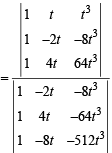
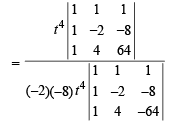
 sq. units.
sq. units.
Q.20. A line through A (–5, –4) meets the line x + 3y + 2 = 0, 2x + y + 4 = 0 and x – y – 5 = 0 at the points B, C and D respectively. If (15/AB)2 + (10/AC)2 = (6/ AD)2, find the equation of the line. (1993 - 5 Marks)
Ans. 2x + 3y + 22 = 0
Sol. Let θ be the inclination of line through A (– 5, – 4). Therefore equation of this line is
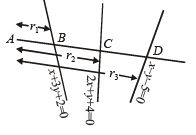

⇒ B (r1 cosθ– 5, r1 sinθ – 4)
C (r2 cosθ – 5, r2 sinθ – 4)
D (r3 cosθ – 5, r3 sinθ – 4)
But B lies on x + 3y + 2 = 0. therefore r1 cosθ – 5 + 3r1 sin θ – 12 + 2 = 0

 … (1)
… (1)
As C lies on 2x + y + 4 = 0, therefore 2 (r2 cosθ – 5) + (r2 sinθ – 4) + 4 = 0

 = 2cosθ + sinθ … (2)
= 2cosθ + sinθ … (2)
Similarly D lines on x – y – 5 = 0, therefore r3 cosθ – 5 – r3 sinθ + 4 – 5 = 0

 … (3)
… (3)
Now, ATQ
⇒ (cosθ + 3 sinθ)2 + (2 cosθ + sinθ)2 = (cosθ – sinθ)2 [Using (1), (2) and (3)]
⇒ 4 cos2θ + 9 sin2θ + 12 sinθ cosθ = 0
⇒ 2 cosθ + 3 sinθ = 0

∴ Equation of req. line is y + 4 = 
⇒ 2x + 3y + 22 = 0
Q.21. A rectangle PQRS has its side PQ parallel to the line y = mx and vertices P, Q and S on the lines y = a, x = b and x = –b, respectively. Find the locus of the vertex R. (1996 - 2 Marks)
Ans. x(m2 -1) - ym+ (m2 +1)b + am = 0
Sol. Let the co-ordinates of Q be (b, a) and that of S be (– b, b).
Let PR and SQ intersect each other at G.
∵ G is the mid pt of SQ. (∵ diagonals of a rectangle bisect each other)
∴ x co-ordinates of G must be a.
Let the co-ordinates of R be (h, k).
∴ The x-coordinates of P is – h (∵ G is the mid point of PR)
As P lies on y = a, therefore cordinates of P are (– h, a).
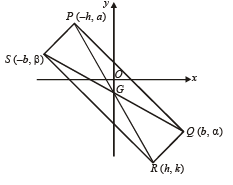
∵ PQ is parallel to y = mx, Slope of PQ = m
 = a + m (b+h)… (1)
= a + m (b+h)… (1)
Also RQ ⊥ PQ⇒
Slope of 
 … (2)
… (2)
From (1) and (2) we ge
a + m (b + h) 
⇒ (m2 – 1) h – mk + b (m2 + 1) + am = 0
∴ Locus of vertex R (h, k ) is (m2 – 1) x – my + b (m2 + 1) + am = 0.
Q.22. Using co-ordinate geometry, prove that the three altitudes of any triangle are concurrent. (1998 - 8 Marks)
Ans.
Sol. Let A (x1, y1), B (x2, y2), C (x3, y3) be the vertices of ΔABC
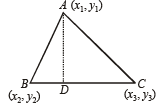
Then equation of alt. AD is

or(x – x1) (x2 – x3) + (y – y1) (y2 – y3) = 0 … (1)
Similarly equations of other two attitudes are
(x – x2) (x3 – x1) + (y – y2) (y3 – y1) = 0 …(2)
and (x – x3) (x1 – x2) + (y – y3) (y1 – y2) = 0 …(3)
Now, above three lines will be concurrent if

On L.H.S.
Operating R1 + R2 + R3, R1 becomes row of zeros.
∴ Value of determinant = 0 = R.H.S.
Hence the altitudes are concurrent.
Q.23. For points P = (x 1, y 1) an d Q = (x2, y2) of the co-ordinate plane, a new distance d(P, Q) is defined by d(P, Q) = |x1 – x2| + |y1 – y2|. Let O = (0, 0) and A = (3, 2). Prove that the set of points in the first quadrant which are equidistant (with respect to the new distance) from O and A consists of the union of a line segment of finite length and an infinite ray. Sketch this set in a labelled diagram. (2000 - 10 Marks)
Ans.
Sol. Let P = (h, k) be a general point in the first quadrant such that d (P, A) = d (P, O)
⇒ | h – 3 | + | k – 2 | = | h | + | k | = h + k … (1)
[h and k are + ve, pt (h, k) being in I quadrant.]
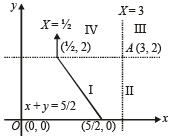
If h < 3, k < 2 then (h, k) lies in region I.
It h > 3, k < 2, (h, k) lies in region II.
If h > 3, k > 2 (h, k) lies in region III.
If h < 3, k > 2 (h, k) lies in region IV.
In region I, eq. (1)
⇒ 3 – h + 2 – k = h + k ⇒ h + k = 
In region II, eq. (1) becomes
⇒ h – 3 + 2 – k = h + k ⇒ k =  not possible.
not possible.
In region III, eq. (1) becomes
⇒ h – 3 + k – 2 = h + k ⇒ – 5 = 0 not possible.
In region IV, eq. (1) becomes
⇒ 3 – h + k – 2 = h + k ⇒ h = 1/2
⇒ Hence required set consists of line segment x + y = 5/2 of finite length as shown in the first region and the ray x = 1/2 in the fourth region.
Q.24. Let ABC and PQR be any two triangles in the same plane.
Assume that the prependiculars from the points A, B, C to the sides QR, RP, PQ respectively are concurrent. Using vector methods or otherwise, prove that the prependiculars from P, Q, R to BC, CA, AB respectively are also concurrent. (2000 - 10 Marks)
Ans.
Sol. Let the co-ordinates of the vertices of the ΔABC be A (a1, b1), B(a2, b2) and C (a3, b3) and co-ordinates of the vertices of the ΔPQR be P (x1, y1), B (x2, y2) and R (x3, y3)
Slope of 
⇒ Slope of straight line perpendicular to

Equation of straight line passing through A (a1, b1) and perpendicular to QR is

⇒ (x2 – x3)x + (y2 – y3) y – a1 (x2 – x3) – b1 (y2 – y3) = 0 … (1)
Similarly equation of straight line from B and perpendicular to RP is (x3 – x1) x + (y3 – y1) y – a2 (x3 – x1) – b2 (y3 – y1) = 0 … (2)
and eqn of straight line from C and perpendicular to PQ is (x1 – x2) x + (y1 – y2) y – a3 (x1 – x2) – b3 (y1 – y2) = 0 … (3)
As straight lines (1), (2) and (3) are given to be concurrent, we should have
 … (4)
… (4)
Operating R1 → R1 + R2+R3 , we get

where

Expanding along R1
⇒ [(x3 – x1) (y1 – y2) – (x1 – x2) (y3 – y1) ] S = 0


which is not possible in ΔPQR]
⇒ a1 (x2 – x3) + b1 (y2 – y3) + a2 (x3 – x1) + b2 (y3 – y1) + a3 (x1 – x2) + b3 (y1 – y2) = 0 … (5)
⇒ x1 (a3 – a2) + y1 (b3 – b2) + x2 (a1 – a3) + y2 (b1 – b3) + x3 (a2 – a1) + y3 (b2 – b1) = 0 ...(6)
(Rearranging the equation (5)) But above condition shows
 ...(7)
...(7)
[Using the fact that as (4) ⇔ (5) in the same way (6) ⇔ (7)]
Clearly equation (7) shows that lines through P and perpendicular to BC, through Q and perpendicular to AB are concurrent. Hence Proved.
Q.25. Let a, b, c be real numbers with a2 + b2 + c2 = 1. Show that
the equation 
represents a straight line. (2001 - 6 Marks)
Ans.
Sol. 
Applying C1 → C1 + bC2+ cC3


as a2 + b2 + c2 = 1
C2 → C2- bC1 and C3 → C3- cC1


R1 → R1 + yR2+R3

On expanding along R1

= (x2 + y2 + 1) (ax + by + c)
Given Δ = 0
⇒ ax + by + c = 0, which represents a straight line.
[∵ x2 + y2 + 1 ≠ 0, being + ve].
Q.26. A straight line L through the origin meets the lines x + y = 1 and x + y = 3 at P and Q respectively. Through P and Q two straight lines L1 and L2 are drawn, parallel to 2x – y = 5 and 3x + y = 5 respectively. Lines L1 and L2 intersect at R. Show that the locus of R, as L varies, is a straight line. (2002 - 5 Marks)
Ans.
Sol. The line y = mx meets the given lines in
 and
and 
Hence equation of L1 is

⇒ y – 2x – 1 =  … (1)
… (1)
and that of L2 is

⇒ y + 3x – 3 =  … (2)
… (2)
From (1) and (2)

⇒ x – 3y + 5 = 0 which is a straight line.
Q.27. A straigh t lin e L with negative slope passes thr ough the point (8, 2) and cuts the positive coordinate axes at points P and Q. Find the absolute minimum value of OP + OQ, as L varies, where O is the origin. (2002 - 5 Marks)
Ans. 18
Sol. Let the equation of the line be (y – 2) = m (x – 8) where m < 0
 and Q ≡ (0, 2- 8m)
and Q ≡ (0, 2- 8m)
Now, OP + OQ 

Q.28. The area of the triangle formed by the intersection of a line parallel to x-axis and passing through P (h, k) with the lines y = x and x + y = 2 is 4h2. Find the locus of the point P. (2005 - 2 Marks)
Ans. y = 2x +1 or y = -2x +1
Sol. A line passing through P (h, k) and parallel to x-axis is
y = k. … (1)
The other two lines given are
y = x … (2)
and x + y = 2 … (3)
Let ABC be the Δ formed by the points of intersection of the lines (1), (2) and (3), as shown in the figure.

Then A (k, k), B (1, 1), C (2 – k, k)
∴ Area of ΔABC = 
Operating C1 – C2 we get


⇒ k – 1 = 2h or k – 1 = – 2h
⇒ k = 2h + 1 or k = – 2h + 1
∴ Locus of (h, k) is, y = 2x + 1 or y = – 2x + 1.
|
446 docs|929 tests
|
















